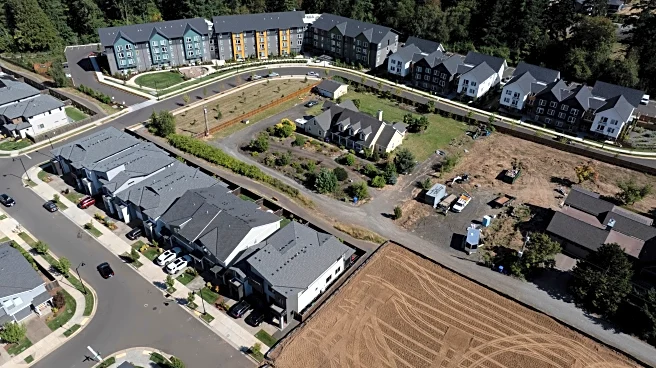What's Happening?
The National Association of Realtors announced that sales of previously occupied U.S. homes increased by 1.5% in September compared to August, reaching a seasonally adjusted annual rate of 4.06 million
units. This marks the fastest sales pace since February. The rise in sales is attributed to declining mortgage rates and an increase in available properties, encouraging more home shoppers. The national median sales price also climbed by 2.1% from the previous year to $415,200, marking the highest median sales price for any September since 1999. Despite the increase, the sales figure slightly missed economists' expectations of 4.07 million units. The housing market has been in a slump since 2022 due to rising mortgage rates, but recent declines in rates have improved purchasing power for homebuyers.
Why It's Important?
The acceleration in home sales is significant as it indicates a potential recovery in the U.S. housing market, which has been struggling due to high mortgage rates and limited inventory. Lower mortgage rates enhance homebuyers' purchasing power, potentially leading to increased market activity. However, borrowing costs remain high, making it difficult for many Americans to afford homes, especially first-time buyers who lack home equity gains. The increase in available properties suggests a shift towards a more balanced market, although inventory levels are still below pre-pandemic figures. This development could impact real estate stakeholders, including buyers, sellers, and real estate agents, as well as influence broader economic indicators related to housing.
What's Next?
The housing market may continue to see fluctuations as mortgage rates evolve and economic conditions change. If rates continue to decline, it could further stimulate home sales and potentially ease the affordability crisis. However, the chronic shortage of affordable homes remains a challenge, particularly for first-time buyers. Stakeholders will likely monitor Federal Reserve decisions on interest rates closely, as these will influence mortgage rates and, consequently, the housing market dynamics. Additionally, the market's response to the increased inventory and its impact on home prices will be crucial in determining future trends.
Beyond the Headlines
The ongoing changes in the housing market could have long-term implications for economic inequality and urban development. As home prices continue to rise, affordability becomes a pressing issue, potentially widening the gap between different socio-economic groups. The shift in inventory levels might also influence urban planning and housing policies, prompting discussions on sustainable development and affordable housing initiatives. These factors could shape the future landscape of U.S. cities and communities.













